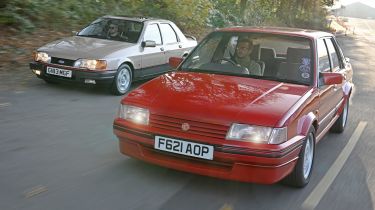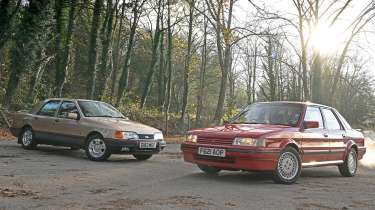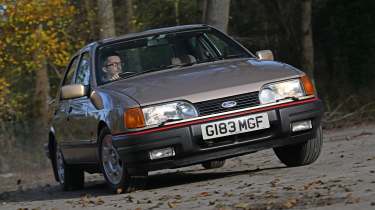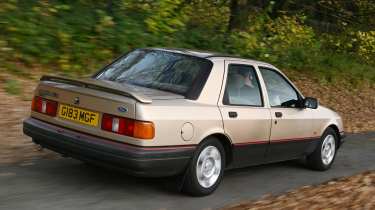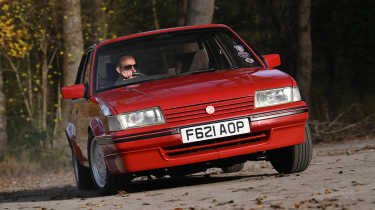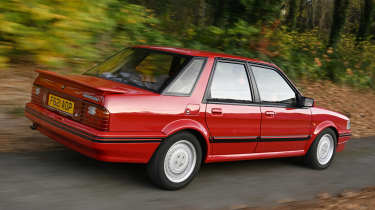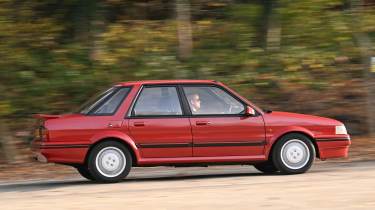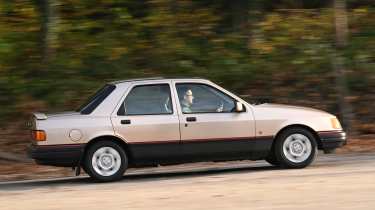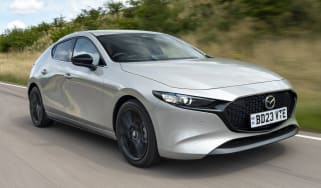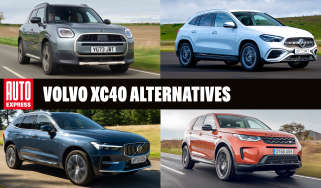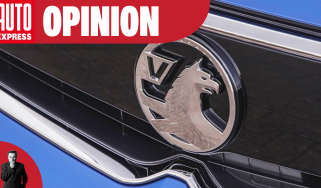Ford Sierra vs MG Montego retro test: they were acceptable in the 80s, but what about now?
When Auto Express first hit newsagents’ shelves in 1988, these popular saloons were battling it out in company car parks. Some 36 years later, how will they fare as we put them to the test?
For this very special test, you find us in reflective mood. The year is 1988. Kylie Minogue’s self-titled debut album is the biggest selling record of the year; NASA has launched the first shuttle Discovery on a four-day mission into space; and this writer has yet to have his first birthday.
It was also the year that marked the birth of Auto Express magazine. It didn’t take us long to establish ourselves as the place to come for the latest scoops and reviews in the automotive world, and the same remains true today. The car market was flying, too. Sales were at an all-time high, with figures for the previous year breaking the two-million mark for the first time.
Saloons ruled the company car market and were huge business for fleet managers. At a time when boot badges were your calling sign for success, letters like GLX, SRI and CD made middle managers stand out from the crowd.
Another important three-letter acronym was EFi – electronic fuel injection – used by both of these contenders. Our two challengers ruled the outside lane at the time: Ford’s Sierra had been a mainstay in the market for a while, but it wasn’t until a hefty mid-life facelift in 1987 that the saloon-bodied Sapphire arrived, along with a multitude of revisions that kept it feeling fresh.
Facing off against here it is the very best that Rover Group had to offer at the time. The Montego was also among the UK’s most popular saloons in 1988, and a little extra spice here comes in the form of the sporty MG model. In September 1988, when Auto Express launched, just £114 split these two cars on list price before options, so this is a true grudge match.
But which is better? To find out, we got behind the wheel of both to subject them to the rigorous standards of our latest 2024 road tests to see how well they measure up in a modern context.
Head-to-head
Ford Sierra
Replacing the Cortina was always going to be a daunting task, so Ford chose to be very bold when creating its successor. Not only did the new Sierra nameplate mark the end of 20 years of Cortina production, but the car’s styling – inspired by the Probe III concept – also proved to be too radical for some at first. That aerodynamic shape, and resulting efficiency gains, however, turned around many of the most conservative of buyers, and the car became a huge sales hit. The Sapphire saloon model, driven here, joined a revised Sierra family in 1987.
MG Montego
Much like Ford, Austin-Rover was crying out for a repmobile in the early eighties, with the likes of the Morris Marina (later Ital) and Austin Ambassador falling short of the standards company car drivers demanded at the turn of the decade. The new Montego’s styling thrust the firm into the modern era, with its body-coloured bumpers and crisp profile marking a significant step forward. The Montego gained hotter MG variants in 1985, giving performance saloon fans something to get excited about, too.
On the road
There’s a clear difference in approaches between this pair, with the Sierra focusing on comfort, and the MG adopting a sporty attitude. Despite this, the Ford’s rear-wheel-drive layout makes it feel sweetly balanced through the corners - even if body roll is quite pronounced. The MG is a little tighter, more responsive and just slightly more likely to put a smile on your face. The Sierra’s ride is excellent, though, and it cruises effortlessly at speed.
Price and running costs
Finding an MG Montego on the used market is incredibly hard today, with just a handful left on the road. We found one car available at the time of writing, priced at £7,000. Despite huge sales volumes, ordinary Sierras seem rarer than Cosworths these days, but the more run-of-the-mill Sapphires we uncovered in the classifieds tend to be marginally cheaper. Depending on condition, the asking prices range between £4,000 and £7,000.
Safety
By modern standards, the safety tech on these two seems non-existent – both were developed long before the likes of Euro NCAP imposed ever-more stringent assessments. The Sierra was among the first mainstream cars to offer ABS as an option – albeit an expensive one – while the MG made use of a high-level third brake light. Also optional on both cars were headlight wipers, which ensured that visibility would be good at all times of the year.
Tech highlights
As a spin-off of the mainstream Austin Montego, the MG version offered just two trim variants. Both the MG and the Ford come with 2.0-litre engines with fuel injection, with the Ford falling short of its rival in terms of power and torque. The Sierra line-up also includes 1.6, 1.8 and a non-EFi 2.0-litre four-cylinder petrol, plus a 2.8 V6. The MG and Ford each use turbochargers in their range-toppers, but the Cosworth’s 200-plus bhp takes things a leap further.
Practicality
Of the two, the Sierra is the more spacious option here. While the transmission tunnel is high in the back, the Ford still offers a third seatbelt that the MG lacks, and Montego passengers must put up with limited rear headroom, too. Both cars have saloon bodystyles, but the MG offers a folding rear seat to boost load capacity. The Ford’s boot opening is also very high, even though the Sierra has more space when fully loaded.
Ownership
Trying to find spare parts for these cars might be tricky these days, but that aside, living with either of them wouldn’t feel like too much of a hardship. Both cars still provide plenty of performance, and on modern tyres they are grippy and forgiving enough to ensure you don’t feel like you have to constantly hold back. If you can live without air-conditioning, the Sierra is as competent a motorway car as many vehicles developed three decades later.
Ford Sierra
| Model: | Ford Sierra Sapphire EFi 2.0 GLS |
| Price new: | £11,060 |
| Price inflation adjusted: | £29,917 |
| Engine: | 4cyl/1,993cc |
| 0-60mph: | 9.3 seconds |
| Top speed: | 118mph |
During the mid-to-late eighties, Ford dominated the UK sales charts. In 1987, the year before our test car rolled off the production line, the Sierra was the third best-selling model in the UK, and the only two cars more popular were Fords, too: the Fiesta ranked second, just behind the Escort. In this purple patch, the Sierra was the darling of company car drivers, offering a combination of space, equipment and comfort that found favour with thousands of fleet users.
However, there was lots of competition to fend off, including models from brands that were newer to the UK market at the time. The key rival was Vauxhall, which towards the end of 1988 released its all-new third-generation Cavalier. One of the most talented challengers came from Peugeot, a brand revitalised in the eighties. The 405 offered a superbly rounded package at a competitive price. Other rivals from France included the Renault 21 and Citroen BX, while the Honda Accord and Volkswagen Passat were alternatives.
Engines & performance
As a high-spec version of the Sierra, our test car is powered by a 2.0-litre four-cylinder petrol engine. Although peaks of 113bhp at 5,500rpm and 160Nm at 4,000rpm don’t sound remarkable by modern standards, the Sierra only has just over 1,100kg to move around. The end result is a car that feels more than up to the task of keeping up with modern traffic. The engine pulls cleanly and smoothly from tickover, and feels strong all the way through its rev range; while we were unable to confirm the claimed 9.3-second 0-60mph time ourselves, it feels completely plausible – despite the fact that the long-throw gearchange seems a little sluggish to use. The engine is more audible than in modern cars, but it’s a fairly anonymous drone rather than anything noticeably unpleasant.
Driving
Being at the wheel of the Sierra reveals plenty of differences compared with modern cars. Some are welcome, but the Ford also highlights areas where modern cars are worse.
Around town
By today’s standards, the Sierra’s dimensions are compact. At 4,468mm long, it’s slightly longer than a current Ford Focus, but at 1,727mm wide (not including the door mirrors) it’s narrower than most new superminis. This makes it much easier to thread along congested urban streets or in and out of tight parking spaces.
Unlike some other cars of this era with unassisted steering, the Sierra’s rear-wheel-drive layout means that the steering rack isn’t having to haul driveshafts around too, so it isn’t too heavy to use. While it still requires a bit of heft when standing still, it lightens up at parking speeds and is easy to use from 10-15mph and above.
Even so, Ford allowed buyers of the 2.0-litre model to specify their car with power-steering. It was a £528 option back in 1998 which, when adjusted for inflation, works out at a not insignificant £1,428.
A/B Roads
Despite its rear-drive layout, and the fact that the GLS model gets a sports suspension package consisting of a thicker front anti-roll bar and variable-rate rear springs, the Sierra isn’t really the choice for keen drivers. The steering is a little light and isn’t loaded with feedback, while there’s plenty of body roll through the turns.
However, these are all compromises we can happily accept when the Sierra proves to be so comfortable. The seats are pleasingly soft, and this is a car that glides over bumps that cause so many modern cars – with their large wheels and low-profile tyres – to fidget and jostle around. It’s a shame that so few of today’s models don’t prioritise ride comfort quite as much as this eighties stalwart.
Motorways
While our test route was largely confined to low speeds, the Sierra’s soft ride, strong engine and impressive aerodynamics would doubtless make it a superb motorway cruiser even by modern standards. Although there have been major advances in noise, vibration and harshness over the decades, some of those changes are necessary to mitigate the fat tyres of modern machines; the Sierra’s smaller, 185-section rubber emits less road noise than family cars from 2024.
MPG and running costs
Long before NEDC and WLTP efficiency testing standards, manufacturers’ claimed mpg figures were easier to verify in the real world. They were assessed on an urban driving cycle, then at constant speeds of 56mph and 75mph; the Sierra does its best at 56mph, where it’s said to achieve 43.5mpg.
Tax
Pre-2001 cars are subject to VED rates based on engine size. Those with a capacity of under 1,549cc cost £210 per year, while those above, like this Sierra, cost £345.
Insurance
Given the Sierra is 36 years old, it will be possible to cover the car through a variety of classic insurers, which means costs might be lower than you think. Based on the example of a typical 40-year-old driver we use for every road test, one classic insurer was willing to cover the Sierra for £248 a year.
Interior and tech
The Sierra’s cabin is neatly laid out and the finish is reasonable if not outstanding.
Design
Once the driver sinks into the superbly soft and comfortable seat, they are presented with a dashboard angled towards them, which gives a sporty feel to the cockpit. The low arms of the two-spoke steering wheel are positioned in such a way that drivers covering huge motorway mileages can hold the rim in a relaxed fashion, while thumb grips at the traditional ten-to-two position are useful for more spirited driving.
There are three stalks on the steering column; controls for the windscreen wiper operation are on a pair of stalks to the right, while a single stalk on the left operates the indicators and headlamp flashers.
The fan speed is adjusted by a round dial just below the driver’s left hand, above which sit vertically sliding levers to control the temperature and air direction. The instruments are clear and neatly laid out, with orange markers on the speedometer showing 30mph and 70mph limits. The electric mirror switch is positioned beside the offside mirror, while the electric window controls are located just behind the gear lever.
Quality
Unlike in many more modern cars, three different interior colours could be selected to match the range of exterior paint finishes. Our test car’s optional Silica Gold metallic is matched to a Mace beige interior, which changes the colour of the dashboard, door cards and fabric to suit. Other options included Bluestone blue plastics, or the more simple Shadow grey. Despite the 85,000 or so miles covered by this model, the plastics felt robust and rattles were few and far between.
Tech and infotainment
The GLS is the second highest trim level of six in the Sapphire line-up – hatchback models at the time were also available in the sporty XR4x4 guise.
The range kicks off with the nameless entry model, whose kit is spartan; a two-speaker radio (minus cassette player) is about the only concession to mod-cons. The L adds a small LCD display in the instrument panel, a six-speaker radio/cassette player, a height-adjustable driver’s seat and a little extra in-car storage. Meanwhile, the LX ups the kit list with a sunroof, a rev counter and a 12-volt cigar lighter, but you’ll need the GL if you want an ashtray.
The GL also adds a central armrest for front and rear occupants, softer cloth trim on the doors, and a light inside the glovebox, while our GLS brings electric front windows, front foglights, a smarter steering wheel and an integrated radio aerial. The Ghia sits at the top of the tree, with lumbar adjustment on the driver’s seat, electric rear windows, uprated audio, a more advanced LCD display, extra interior lighting and rear head restraints. The Ghia is also the only Sapphire to offer air-conditioning as an option.
Practicality
The Sierra is spacious enough to be used as an everyday family car, with a high boot lip one of the few gripes we have.
Front space
While a height-adjustable seat is a feature that helps drivers of many sizes get comfortable, the adjustment control takes the form of a spinning handle, a little like those found on some sunroofs, under the driver’s right thigh. It’s fiddly to use compared with the ratcheted lever that went on to be most common in years to come.
A huge glass area makes visibility impressive, though the far reaches of the boot are hard to judge when reversing. Storage space is very good, with various slots in the dashboard for small items, a large glovebox, long door bins and even a dedicated place to hold cassettes under the front centre armrest.
Rear space
Despite the ever-increasing exterior dimensions of cars, interior space hasn’t changed as much as you might think. Against the tape measure, the Sierra appears to offer about as much kneeroom as a Ford Focus – impressive given that the current Focus is among the roomier cars in its class.
However, by modern standards, headroom and elbow room are reasonable rather than outstanding, and things start to feel a little cramped for middle passengers because the Sierra’s rear-wheel-drive layout means there’s a high transmission tunnel. The rear windows only drop around halfway into the door when opened, too.
Boot space
With 414 litres available, the Sierra’s boot offers a reasonable amount of space. The area is a little misshapen due to intrusion from the rear wheelarches, but the main issue here is the height of the boot lip. The Sierra’s boot opens from just above the tail-lights, which means that the lip is high and the opening a little small.
Reliability and safety
For its time the Sierra was ahead of the family car curve in terms of safety kit. Every model in the range could be upgraded with optional anti-lock brakes; they were an expensive upgrade at £977 – £2,643 in today’s money – but one that could save lives. Few rivals offered the same tech, although the new Vauxhall Cavalier was one that did. Only once the Mondeo arrived to replace the Sierra could you could have an airbag, though.
Warranty
Buyers are certainly better covered when it comes to possible faults in 2024 than they were back in the late eighties. The Sierra came with just a single year of warranty cover.
It was possible to pay for a longer policy of up to three years/60,000 miles – a level of cover that’s offered by Ford to its customers free of charge today – but that would have cost an inflation-adjusted £857 in 1989.
What we said
Back in the very first issue of Auto Express, we tested the Sierra against the Peugeot 405 and the Vauxhall Cavalier. At the time, the Ford was fighting against much newer rivals, yet it held its own. We found that “its solidity and comfort are not seriously bettered by the newer cars” but its body control was a little off the class best by this point. Its rear-wheel-drive layout gave the Sierra the best turning circle and the lightest steering, but caused traction issues. We noted that “the rear wheels can slide out of line when accelerating out of tight corners”.
MG Montego
| Model: | MG Montego 2.0i EFi |
| Price new: | £11,174 |
| Price inflation adjusted: | £30,225 |
| Engine: | 4cyl/1,994cc |
| 0-60mph: | 8.9 seconds |
| Top speed: | 116mpg |
Although Ford very much ruled the roost in 1988, one of the biggest-selling automotive empires in the UK remained, with British Leyland having changed its name to Austin-Rover and, from 1988, Rover Group.
While it didn’t quite reach the same sales volumes as its blue oval rival at the time, cars like the Metro, Maestro and Montego were regulars among the top 10 best sellers.
The Montego first hit the road in 1984, badged as an Austin. It came a year after the Maestro hatchback, with which the Montego shared a platform, doors and central body structure – although the saloon gained roughly 60mm in length to deliver the kind of luggage space buyers in this segment desired.
The MG variant was launched in 1985, and offered a sportier version of the standard Montego, gaining deeper front bumpers, striking alloy wheels and a rear spoiler.
Beside the Sierra Sapphire, which looks relatively rounded in profile despite not being quite as soft as the ‘jelly mould’ hatchback version, the MG’s sharp lines appear more purposeful, if a little more old-fashioned.
The MG Montego was also rarer than the standard Austin model; for every MG version sold, British Leyland shifted almost 24 Austin models. However, the MG was still priced competitively to take on the Ford. Buyers looking for a saloon alternative could consider the same rivals as the Sierra, but those able to stretch their budget could consider the Alfa Romeo 75, BMW 3 Series and Mercedes 190E.
Engines & performance
Power for the Montego comes from a 2.0-litre version of the O-series family of engines that launched in the late seventies. The key feature here, in addition to its single overhead camshaft configuration and aluminium cylinder head, is the inclusion of a Lucas electronic fuel-injection system.
This enabled the four-cylinder unit to make 115bhp, putting it marginally ahead of the Sierra. More impressive is the peak torque figure of 182Nm; not only is that 22Nm up on its rival, but it arrives 1,200rpm sooner, at 2,800rpm. The result is that the MG chops 0.4 seconds from the Ford’s 0-60mph time, covering the sprint in a lively 8.9 seconds.
Sitting above the 2.0 EFi in the Montego family was a turbocharged model. Adding a Garret T3 turbo saw the output rise to 150bhp, although this variant used a more old-fashioned single-choke carburettor instead of electronic fuel injection.
The resulting 0-60mph time of 7.3 seconds made it the fastest production model MG had manufactured at the time, and flat out it would hit 126mph – 10mph up on the EFi.
Driving
Of the two, the MG has a more sporty attitude from behind the wheel, with a little comfort traded for a more direct response. Assessed by modern standards, the MG would be the car that feels more enjoyable more of the time.
Around town
An unassisted steering rack, combined with a fairly small wheel, means that parking can be a bit of a workout in the Montego. Even once it’s rolling, the steering remains heavy, but it offers more feedback than the lifeless set-up in the Sierra. At 10.5 metres, the MG’s turning circle is tight, but the Ford is better at just 10.0 metres. All-round visibility is excellent, with a low shoulder line and large glass area lending a great view.
A/B Roads
Steering aside, the MG has a more lively demeanour than the Ford. The controls feel sharper and more sensitive; the brakes are more positive; the gearbox is light and quicker through the gate, and the throttle response is sharper. The steering lightens up somewhat on the move, and like the rest of the controls, feels more responsive than its rival’s. The ride is also a little firmer, picking up imperfections that the Sierra glides across, yet it’s still soft by the standard of modern cars. There’s some body roll through the turns, but it’s at a level where the weight transfer helps the driver to easily read how the car and tyres are behaving.
Motorways
The Montego is definitely second best when it comes to refinement on the motorway, where its additional noise and firmness mean it’s more tiring to drive than the Ford, which has a softness to all of its controls that make it more relaxing. If we had to take one of these two for a long motorway slog, the Sierra would get the nod. But at the time, the new Vauxhall Cavalier was better than both for cruising refinement.
MPG and running costs
Based on the same UK government testing standards of the time, the MG offers a very similar return to its rival here. At 27.3mpg, the Montego beats the Sierra to the tune of 1.1mpg around town, but at higher speeds, it’s the Ford that just holds the upper hand.
Tax
Like the Ford, the MG’s VED costs come to £345 a year, or £30.18 a month by Direct Debit.
Insurance
Based on our quote from a classic insurer, the MG was slightly cheaper to cover than the Ford, at £193 per year.
Interior and tech
A range of performance-inspired highlights lift a cabin that otherwise doesn’t look quite as fresh as the Ford’s.
Design
The Montego instantly feels like a more sporty place to sit – and that’s not just because of the supportive sports seats. The small, attractive three-spoke steering wheel has a leather-trimmed rim and a red MG logo at its centre, while there are subtle red highlights elsewhere, all of which put you in the mood for some enthusiastic driving.
The rest of the cabin looks a little more square and old-fashioned than the Ford’s, although the lower line of the dashboard makes it more spacious up front. The lights on the column stalk are fiddly to operate, though, and we prefer the layout of the Ford’s instruments for overall clarity.
Quality
The plastics don’t quite feel as sturdy inside the MG as they do in its rival, and the flat door panels are skinnier and more flimsy than the gently curved panels in the Sierra.
Tech and infotainment
When it comes to tech, the Sierra’s equipment list has the Montego beaten. Ford stole a march on the competition with its heated windscreen, and its optional ABS isn’t available at all on the Montego. Power steering is a cheaper upgrade on the MG, though, and a digital clock and radio/cassette player came as standard.
Also among the included kit are the likes of alloy wheels (an option on the Sierra), a rev counter, courtesy lights in the glovebox and boot, and an electric sunroof – the Ford has a manually operated roof.
The Turbo model was even more well equipped, adding a better stereo, extra interior lighting, a second cigar lighter, standard power steering, uprated dampers and heated door mirrors.
Practicality
At 4,466mm long, the Montego is just 2mm shorter than the Sapphire, and a modest 17mm narrower, too. However, it’s the Ford that’s the better packaged of the two, offering more space both inside and the boot.
Front space
There isn’t as much storage in the MG as there is in the Ford, but a large shelf on the top of the passenger side of the dash has a rubberised surface to hold lighter items in place. The MG’s seat has much more adjustment fore and aft than the Ford’s, but as with its rival, there’s no steering wheel adjustment. Of the Montego’s closest rivals, the Peugeot 405 is one of very few to offer that feature, but the French car also lacks a height-adjustable driver’s seat.
Rear space
The Montego’s main Achilles heel is rear headroom, and even adults of average height will start to feel a little cramped back there. On the other hand, kneeroom is as good as in the Sierra, there’s loads of foot space under the front seats, and the seats themselves, although not quite as sumptuous as the Sierra’s, offer slightly better under-thigh support and thicker side bolsters. There’s also a big, soft rear centre armrest, which rotates into place on a beautifully engineered pivoting hinge.
Boot space
With a capacity of 304 litres, the MG’s boot is a little smaller than its rival’s here, with the main issue being that the rear wheelarches encroach into the space. However, in contrast to the arrangement
in the Sierra, the MG’s rear seat backs can be folded forwards, which increases the overall capacity to 1,090 litres. Changing blown tail-lights is a very easy operation, because the bulb holders are exposed and can be reached just inside of the rear panel.
Reliability and safety
Without ABS and at a time before airbags became commonplace, there aren’t many concessions to safety in the MG. One rare example is a third brake light mounted at the base of the rear window, but it was only available on later models.
Back in 2006, issue 925 of Auto Express revealed that the Montego was one of the most scrapped cars of the last 30 years, with many examples succumbing to rust.
According to howmanyleft.co.uk, just 94 Montegos remain registered on UK roads. Of those, 21 are MGs, with 15 EFi variants to six Turbos still taxed (although many survivors will be garaged off the road, so these numbers are far from definitive). While logic dictates that the remaining examples have been among the very best cared-for, buyers should still be aware of areas beneath the body kit and around all of the body seams and sills for potential signs of corrosion.
Sierras are easier to find, with roughly 2,340 cars still taxed. Ironically, given their popularity at the time, it’s the mainstream ones that are harder to come by. Of that number, Cosworths account for over 1,000 Sierras, and the XR4x4 another 270 or so.
Warranty
Like the Sierra, the Montego was covered for a single year when new. A range of extended warranty packages were offered, with the most comprehensive lifting the cover to three years or 65,000 miles – whichever arrived soonest. In 2024 money, that equates to £1,204 – more than Ford charged on the Sierra.
Verdict
First place: MG Montego
Looking back on these two with hindsight is a wonderful thing, and driving the two back-to-back revealed a fascinating insight into just how much the motoring landscape has changed. One thing the Montego makes clear is that family car buyers in the past were spoiled when it came to humdrum cars that could put a smile on your face; in MG form, it looks fantastic and feels like an event to drive. Find an example with power steering, and as long as you don’t have tall passengers, it’d be a wonderfully fun car to live with every day.
Pros
- Keen throttle response
- Fantastic seats
- Purposeful looks
Cons
- Heavy steering
- Rear headroom
- No ABS option
Second place: Ford Sierra
While the Sierra was a huge sales success at the time, modern tastes have changed slightly, because given the choice to drive one of these two, the Montego would get our nod. There’s an enormous amount to like here, though; the performance of the 2.0-litre model is good enough to surprise many modern cars, while its ride comfort shames several models built since 2020. It’ll be easier to find one on the used market than a Montego these days, but if you want to buy a usable classic or simply re-live some nostalgia, then both are great options.
Pros
- Great ride comfort
- Strong performance
- Generous equipment levels
Cons
- Spongy controls
- Body roll
- High boot lip
Where are they now
With the demise of the Mondeo back in 2022, Ford turned its back on the D-segment, focusing instead on SUVs. Ever-more stringent safety standards, plus customers’ demands for the latest tech, means that new cars have grown in size, too, making the current Focus the closest car in terms of dimensions to the old Sierra. The same is true for price, where the Focus costs roughly £30,000 – or the same as this Sierra cost in 1988 once inflation is taken into account.
MG’s lineage is harder to follow. While the name carries on, today’s company is in a form almost unrecognisable from its days of British ownership, from its roots as an offshoot of Morris (Morris Garages) to the MG Rover Group. Chinese ownership has turned it into a largely electrified and hybrid brand, which makes drawing comparisons very difficult. However, with the all-electric MG 4, the new owners have produced a car strong on value, performance and a chassis that feels engaging – all traits that would have been familiar to MG buyers in the eighties.
Drive them
We want to extend our thanks to Great British Car Journey, the award-winning interactive car museum, for the loan of both the Sierra and the Montego. Based in Derbyshire, the museum goes beyond a typical attraction by also offering visitors the chance to drive one of 50 classics in its “Drive Dad’s Car” experience – and both the Sierra and the Montego are on the fleet.
Great British Car Journey is offering readers a special offer for Christmas: the chance to drive any two cars for £89, down from the usual price of £120. It’s the ultimate trip down memory lane!
To book online, use the discount code AE24 at drivedadscar.com.
Specs
| Ford Sierra | MG Montego | |
| Our choice | GLS 2.0 EFi | 2.0i EFi |
| Price new/inflation adjusted | £11,060/£29,917 | £11,174/£30,225 |
| POWERTRAIN AND PERFORMANCE | ||
| Engine | 4cyl inline/1,993cc | 4cyl inline/1,994cc |
| Fuel injection | Bocsh LJetronic | Lucas Electronic L type |
| Power | 113bhp @ 5,500rpm | 115bhp @ 5,500rpm |
| Torque | 160Nm @ 4,000rpm | 182Nm @ 2,800rpm |
| Transmission | Five-speed man/rwd | Five-speed man/fwd |
| 0-60mph/top speed | 9.3 secs/118mph | 8.9 secs/116mphh |
| Fuel tank | 60 litres | 50 litres |
| Front suspension | MacPherson struts | MacPherson struts |
| Rear suspension | Semi-trailing arm | H-Frame trailing arm |
| Brakes | Vented discs front, drum rear | Vented discs front, drum rear |
| DIMENSIONS | ||
| Length/wheelbase | 4,468/2,609mm | 4,466/2,570mm |
| Width/height | 1,727/1,359mm | 1,710/1,420mm |
| Rear kneeroom | 681-825mm | 648-858mm |
| Rear headroom/elbow room | 888/1,406mm | 844/1,385mm |
| Boot space | 414 litres | 304 litres |
| Boot length/width | 1,034/935mm | 1,010/918mm |
| Boot lip height | 778mm | 654mm |
| Kerb weight/towing weight | 1,115/1,350kg | 1,090/1,250kg |
| Turning circle | 10.0 metres | 10.5 metres |
| COSTS/OWNERSHIP | ||
| MPG Urban | 26.2 | 27.3 |
| MPG 56mph | 43.5 | 43.2 |
| MPG 75mph | 33.6 | 33.5 |
| VED | £345 | £345 |
| Warranty | 1 year | 1 year |
| Insurance quote* | £248 | £193 |
| EQUIPMENT | ||
| Metallic paint/alloy wheels | £436/£679 | £379/yes |
| Front foglight | Yes | No |
| Headlamp washers/heated windscreen | £408/£295 | Opt/no |
| Electric windows/door mirrors | Yes/yes | Yes/yes |
| Central locking/alarm | Yes/yes | Yes/yes |
| Tachometer (rev counter) | Yes | Yes |
| Leather/height-adjustable driver’s seat | No/yes | No/no |
| Digital clock/ashtrays | Yes/three | Yes/three |
| Power steering/leather steering wheel | £1,428/no | £649/yes |
| Sunroof | Manual | Electric |
| Anti-lock brakes | £2,643 | No |
| Auto ’box | £1,566 | No |
| Radio/casette player | Yes | Yes |
*Insurance quotes for both cars from Lancaster via Moneysupermarket

